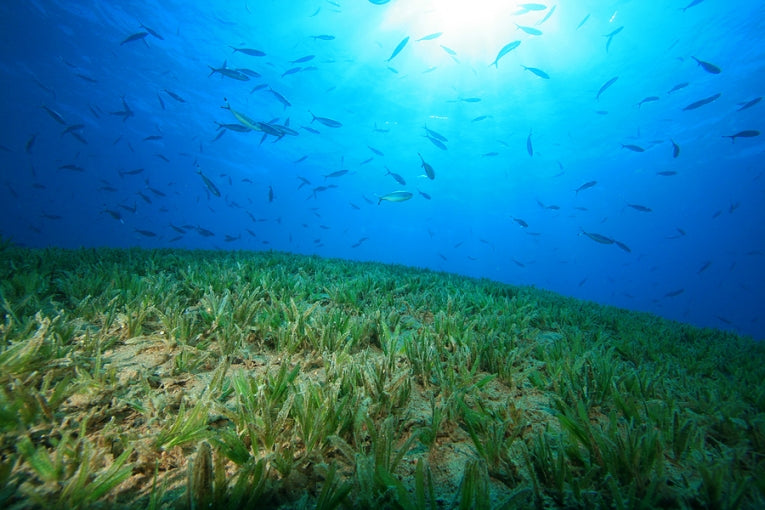In the entire climate change debate the impacts to air have dominated, with water not having featured as a critical medium of impact. Albeit air takes the brunt of the release but destruction of the terrestrial forests and aquatic habitats should also feature on the top 10 climate protection list. The oceanic flora/vegetation like the terrestrial forests are carbon sequesters, that is, they store tons of carbon.
Removing them causes a substantial release into the atmosphere adding to the climate alteration crisis with high levels of green house gases being emitted with their destruction. Conserving terrestrial-aquatic interface vegetation like mangroves, wetlands, riverine vegetation, tidal marshes, salt marshes are all integral to climate change protection. The oceanic flora (viz. seagrasses, seaweed) and the ocean floor itself holds ancient carbon stores.

Figure 1: showing global mangroves blue carbon sinks; Source: UNEP-WCMC, 2009
Blue Carbon refers to coastal, aquatic and marine carbon sinks held by the indicative vegetation and sediments. In the entire climate change talks over the years blue carbon was relegated to the background, only last year was the significance of blue carbon put on the marginal agenda and is now shaping specific fora and debate so as to assign priority significance to blue carbon sinks. The carbon buried in sediments may be as high as 50 times (Conservation International, 2010) that of land sinks.

Figure 2: showing value of coastal ecosystems carbon sinks versus terrestrial forests; Source: Cifuentes & Kauffman
Some of the most important zones of carbon sequestration, aquatic and marine ecosystems, are being rapidly depleted having direct consequences for climate change. Conservation of these zones should feature as a high priority climate protection initiative.

Figure 3: showing global salt marshes blue carbon sinks; Source: UNEP-WCMC, 2009
According to the Blue Carbon Initiative, a collaboration of Conservation International, International Union for Conservation of Nature (IUCN), Intergovernmental Oceanic Commission (IOC) of UNESCO, [in] the last 25 years, roughly 20 percent of Earth's mangroves have been lost. Salt marshes are being lost at an estimated rate of 1-2 percent each year. In the last two decades, about 50 percent of
Earth's seagrass ecosystems have been lost. Draining or clearing for aquaculture and agriculture, coastal pollution, and inappropriate coastal development are some of the main drivers of this loss.

Figure 4: showing global seagrass blue carbon sinks; Source: UNEP-WCMC, 2009
"Losses of seagrass communities, mangroves, and salt marshes have accelerated from around 0.9% per year in the first three quarters of a century to up to 7% per year in the more recent decades. Under current scenarios, most blue carbon sinks will be lost in the next two decades leading to a loss of annual carbon binding capacity equivalent to 4-8% of the total anthropogenic input. Hence, total emissions would therefore have to be reduced by an additional 4-8% by 2030 to retain the status quo, or 10% by 2050. In comparison, the total gain estimated from the UN REDD programme if fully implemented (including slowing deforestation and wide afforestation programmes), would by 2050 according to the IPCC amount to approximately 12-15% of the required emission reductions. Preventing the loss of the oceans blue carbon sinks would mean a significant contribution to reducing climate change, even compared to slowing deforestation of tropical rainforests (A Rapid Response Assessment: Blue Carbon, 2009)."
April 2012 saw preparatory discussions, for UN Conference on Sustainable Development (Rio+20) scheduled for June 2012 in Brazil, where the blue carbon agenda has reached growing significance in the sustainable development agenda.
Destroying aquatic and marine vegetative cover not only releases larges stores of carbon dioxide (CO2) but decimates the habitat provisions for multiple species across the terrestrial and aquatic interface. The coastal zone, stable dunes, stable soils, stable floodplains, stable riparian zones are critical to climate change harsh flood protection needs. In the absence of a regulatory framework and global standards of conservation tied to climate change value of blue carbon, will allow the gap to continue with unabated transformation, conversion and release of carbon from blue carbon zones. Lest we forget, vegetation equals oxygen, and should always be protected. More so, blue carbon is intrinsically tied to mitigating against climate change impacts.










